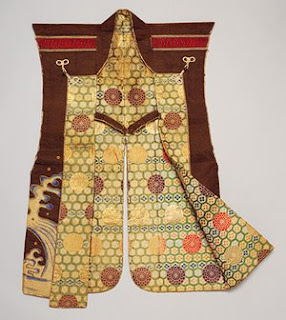In this blog, you will see beautiful fashion designs from prominent Fashion Designers who have incorporated one of the various forms of Art into the designs.

This fashion is referred to as "Iris" dress. Art Noveau, remained throughout the early 2oth century and as a result, the designer created this unique gown by turning to art forms such as "fine art and architecture."
"Iris" dressPainted linen cutwork, silk chiffon and cottonCirca 1905

The beautiful Evening Dress, ca. 1938, designer Mainbocher, was influenced by the "decorative arts" during the period of "revivalism." This gown was worn by Cecil Beaton, the Duchess of Windsor, who wore this dress British Vogue in 1939.
This beatiful Evening coat, ca. 1927, designer by Gabrielle "Coco" Chanel, was inspired by,"the convergence of Art Deco line, the modernististic pure form, and japonisme's to [in order to] offer a vocabulary of untailored wrapping shapes.
Yves Saint Laurent, was influenced by artist Piet Mondian's color block paintings for this unique wool jersey dress. Today, color blocking continues to be used in R-T-W garments such as Michaels Kors polka dot dresses, among other designers. Color blocking requires "precision of pattern-making" and expertise in sewing the color blocked garment.
Dress Multicolor wool jersey1965, YSL

Gianni Versace, was inspired by the work of legend, Andy Warhol. It is noted that Gianni Versace frequently referenced art historical and various cultural aesthetic phenomena.
Evening gown, spring/summer 1991
Dress in Polychrome printed silk with multicolored rhinestone and glass bead embroidery.
 Designer Rudi Gernreich, Black Wool evening dress, 1965-1972, includes the use of "pink and green" appliqued circles. The inspiration for this unique dress was "Pop-Art."
Designer Rudi Gernreich, Black Wool evening dress, 1965-1972, includes the use of "pink and green" appliqued circles. The inspiration for this unique dress was "Pop-Art."
The colors used were very bold and stood out tremendously against the black background of which made this garment one of a kind.

Designer, Emilio Pucci, Dress in Multicolor silk jersey Circa, 1965, was inspired by "Op-Art" infused patterns. Also known as Optical Art, it is a form of abstract art of which geometric shapes are a key factor in additon to creating a 3 dimensional vibrating effects to the eyes of the viewer. Pucci apparel is very well known for the use of Op Art.

One of the more prominent designers, Yamamoto, is well known for apparel that is unique in design and construction. This beautiful Coat, early 1990's, was created in Black felted wool with gold metallic handpainted surface decoration and brass plate appliqué . Within the mirror-like images, the inspiration includes "a Surrealist element" of which was often used by artist Salvador Dali, who was also a key inspiration for designers such as Elsa Schiaparelli who created the Lobster dress based on Dali's "Lobster Painting."

















+White+Silk+Jersey.jpg)

+Edo+Period+(1615-1868)+17th+Century+Japan.jpg)
 The panels of which makes this sleeveless jacket is a form of "tailoring." Cut pieces to create the pattern combined with decorative overlayering (central paneling) is also tailoring. This unique "... piece features a decorative composition" which includes " ... garden rock and bamboo in gold and silver threads and silks in shades of blue,... [and the] ... central panel consists of a fretwork with leaves, also woven with metallic threads. " Primarily worn by over robes by female members of the Qing dynasty's ruling family.
The panels of which makes this sleeveless jacket is a form of "tailoring." Cut pieces to create the pattern combined with decorative overlayering (central paneling) is also tailoring. This unique "... piece features a decorative composition" which includes " ... garden rock and bamboo in gold and silver threads and silks in shades of blue,... [and the] ... central panel consists of a fretwork with leaves, also woven with metallic threads. " Primarily worn by over robes by female members of the Qing dynasty's ruling family.

